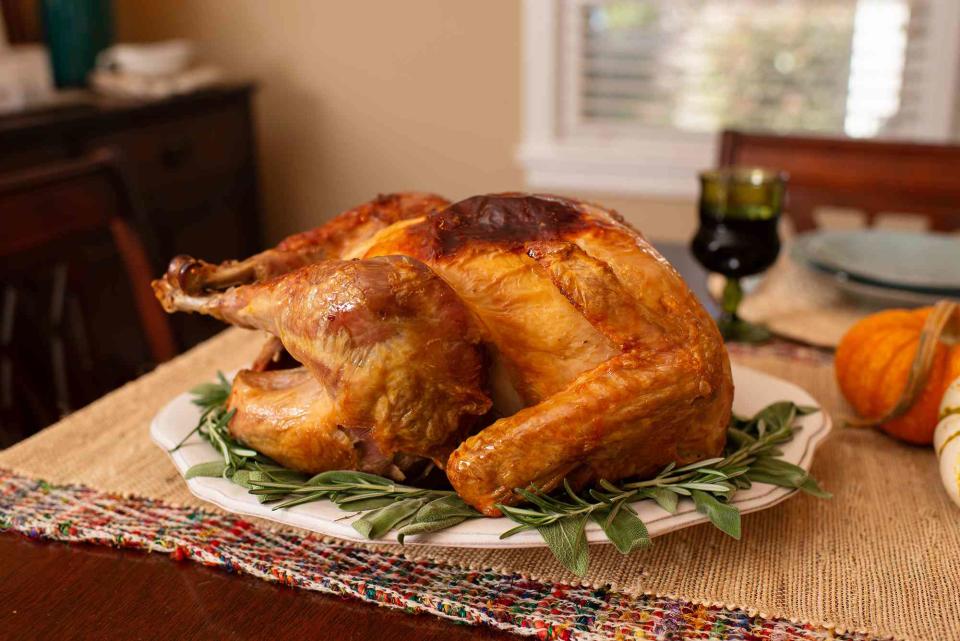The Unexpected Best Way To Roast a Turkey, According to the Experts at Jennie-O
How did we never think to do this before?

Cooking Thanksgiving dinner is a massive feat. Between roasting a whole bird and making all the sides and desserts, Thanksgiving cooking is a marathon event. As with most cooking, everyone has their tried-and-true recipes and methods they turn to for the best possible meal. But, we here at Allrecipes are always looking for new ways to make food taste better, and make cooking it easier.
Whether that be adding Boursin to mashed potatoes, adding pepper to pie, or taking the time to brine your turkey, we want you to be equipped the best Thanksgiving secrets out there. And the experts at Jennie-O just let us in on one of the greatest ones: how to create the juiciest turkey without even having to baste it.
When the turkey is in the oven, and you’re running around prepping five other dishes, the last thing you want to do is stop to baste your turkey every 30 minutes. But, we all know that basting adds extra moisture and flavor to the turkey meat and skin—so, skipping the step can result in a less-than-perfect bird.
That’s why Chef Barry Greenberg, the culinary team lead at Hormel Foods (which owns Jennie-O), has always followed his Aunt Ruthe's method: cooking the turkey upside down. Ok, so maybe this isn’t a tip from the true Jennie-O experts—whose Thanksgiving turkey credentials include a partnership with the Macy’s Thanksgiving Day Parade and an emergency turkey hotline—but we trust generational home cooks just as much as any expert.
Why You Should Roast Your Thanksgiving Turkey Upside Down
“My Aunt Ruthe used to roast her Thanksgiving turkey upside down and it turned out great,” Greenberg told Allrecipes. “You can definitely taste the difference.”
When Greenberg says to roast the turkey upside down, what he really means is flip the turkey over and cook the bird breast-side down.
By cooking your turkey upside down, all of the juices that normally drip to the bottom of the pan—the ones you’d use to baste your turkey—naturally seep into the breast. So, instead of wasting all those beautiful, flavorful juices that typically soak into the bottom of the turkey (where there is dark meat and bones), they’ll flavor your breast instead.
“The theory is that the turkey [fat] drips into the breasts and [makes it] basically a self-basting turkey,” Greenberg said.
Not only will the turkey get juicy because it bastes itself, but roasting it upside down also ensures that you don’t accidentally overcook it and dry it out. Because the breast is typically closer to the stove element on top, it’s easier to dry the meat out while waiting for the rest of the bird to cook. If the breast is on the bottom, it’s not as close to those burners—and it’s sitting in all those drippings, which will keep it moist.
The only downside to cooking your bird upside down is that your breast meat won’t get that gorgeous brown color or have naturally crispy skin. But, if you still want crispy skin and a golden-brown finish, Chef John has a tip for you. After you cook your turkey to an internal temperature of 180 degrees F, carefully flip the bird back over and stick it under the broiler for about five minutes. That will crisp up the skin and lightly brown it for a more appealing-looking turkey.
If you're ready to try the method out this Thanksgiving, you can absolutely use your traditional turkey recipe and just flip it upside down before you pop it in the oven. Or, we recommend this Chef John recipe for an upside-down turkey and stuffing cooked in just two hours. You can thank us later.
Get the Recipe: Fast Upside-Down Turkey
Read the original article on All Recipes.

